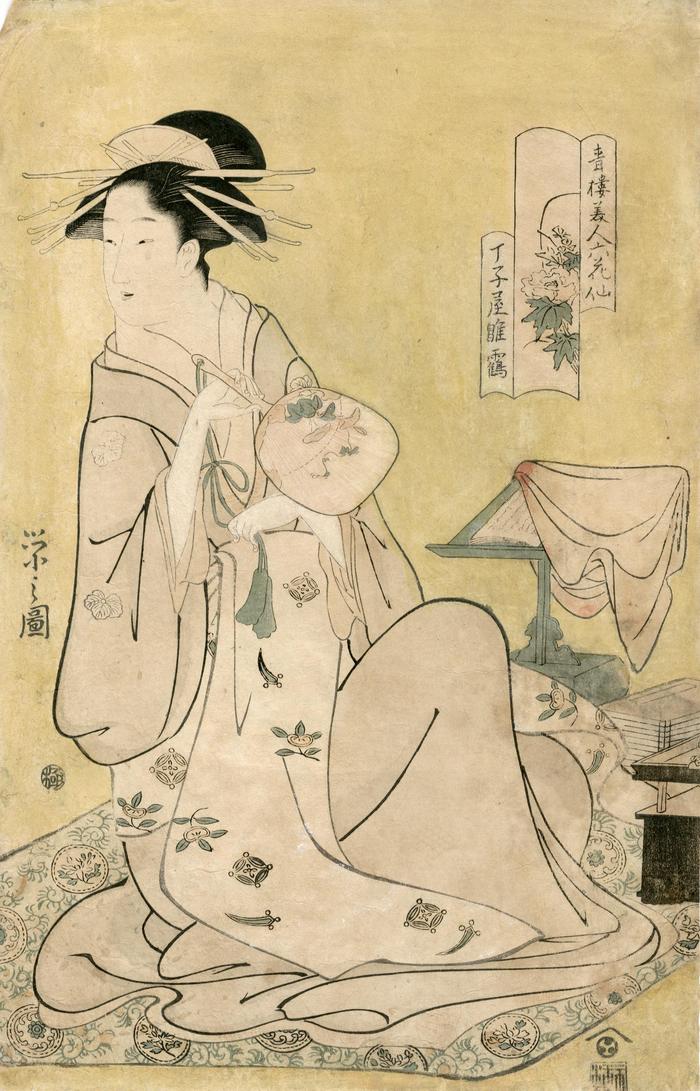Hosoda Eishi (細田栄之) (artist 1756 – 1829)
Hinazuru of the Chōjiya (丁子屋雛鶴) from the series Beauties of the Yoshiwara as Six Floral Immortals (Seirō bijin Rokkasen - 青楼美人六花仙)
ca 1794 – 1795
9.375 in x 14.562 in (Overall dimensions) Japanese woodblock print
Signed: Eishi zu (栄之図)
Publisher: Nishimuraya Yohachi
(Marks 391 - seal 23-016)
Censor's seal: kiwame
Metropolitan Museum of Art
Kanagawa Prefectural Museum of Cultural History
Museum of Fine Arts, Boston
Minneapolis Institute of Arts
Muzeum Sztuki i Techniki Japońskiej Manggha, Krakow
Google maps - Yoshiwara Shrine - one of the only signs of where this famous district was
Metropolitan Museum of Art - print of Hinazuru by Utamaro from ca. 1794
Bibliothèque nationale de France - Morokoshi of the Echizenya from this series Flowers representing courtesans in this series are contained in the koma-e or inset picture next to the title cartouche. While we can't prove our hypothesis that these figures of beautiful women parallel the classical representations of the Six Immortal Poets (Rokkasen - 六歌仙) we are still looking into this and expect that in time the evidence will become clear.
****
Over the history of this house at least 6 or more women were honored to carry this name. "...Shunshō (?1726-92) was commissioned to paint a special portrait of the grand courtesan Hinazuru by a man who had been her loyal patron over many years: Shunshō was to paint her in her most sumptuous costume of a black surcoat embroidered with peacock feathers and turquoise brocade obi (sash) and then add the jewelled crown and necklaces, and the lotus flower pedestals of the Bodhisattva Kannon on her passage to rebirth in the Pure Land Paradise.... [Later] the old roué would gaze at the painting with nostalgic longing and compose poems to it, one of which reads: 'Even on an old man's body/that looks like a withered tree/this female Bodhisattva/makes flowers bloom.' "
Quoted from: Ukiyo-e Paintings in the British Museum by Timothy Clark, p. 8.
The Hinazuru in this Eishi print must have excited the juices of many a great artist and publisher. She was portrayed by Eishō, Chōki, Eisui, Eiri and Utamaro. Earlier examples who used this name were presented by Harunobu, Kiyonaga, Koryūsai and Masanobu.
****
The mon of the Chōjiya was a crane, but none appears here in this print. A peony (?) appears in the title cartouche and morning glories () decorate the courtesan's fan. There are several Buddhist references, too. Her robe is decorated with the endless knot and there are at least two of the sacred jewels seen on what appears to be her untied, unfurled obi.
Hinazuru, an educated woman, has been reading as is indicated by the book-stand situated near her. It is only partially covered with a protective cloth. A stack of other books lie near the stand, waiting to be read.
****
The curatorial files at the Met say of this print: "At the Chōjiya (House of the Cloves) brothel in Yoshiwara, more than a half dozen courtesans over the course of successive generations styled themselves “Hinazuru” (literally, “baby crane”). The title of this series includes the phrase rokkasen, which sounds like it should mean Six Poetic Immortals, but the character for “poetry” has been playfully substituted with the one for “flower,” suggesting that the women of the pleasure quarters are being compared to beautiful flowers.
Each print in this series has a different flower in the title cartouche; here, a peony is included."
****
There is another copy of this print in the Worcester Art Museum.
beautiful woman picture (bijin-ga - 美人画) (genre)
Nishimuraya Yohachi (西村屋与八) (publisher)
mitate-e (見立て絵) (genre)
